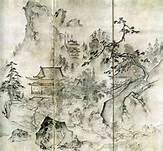Art of Japan and Tensho Shubun: Middle Kingdom to the power of Buddhism
Lee Jay Walker
Modern Tokyo Times

The Japanese artist Tensho Shubun was deeply influenced by landscape artists from the Middle Kingdom (China). Indeed, Shubun is noted for being one of the founding fathers of introducing Chinese-style ink painting in the land of the rising sun – along with Josetsu (a naturalized Chinese immigrant who blessed Japan). This ink painting in Japan is called suiboku and when fused with Buddhism many intricate ideas emerged for Shubun during his informative years.
It is known that Shubun became a professional artist at a relatively young age in the early fifteenth century. His rise was meteoric within the Bureau of court painting that became firmly established during the shoguns of Ashikaga. Therefore, he even participated in diplomatic areas related to the important mission to the Kingdom of Joseon (Korea) in 1423.

At the same time, the powerful holy temple of Zen Buddhism called Shokoku-ji became important for Shubun. Similarly, the highly cultured Josetsu, an immigrant from the Middle Kingdom, inspired Shubun. Hence, the flows of suiboku and art from the Song Dynasty of the Middle Kingdom reached Shubun through Josetsu. This reality came at a very opportune moment for Shubun in his early career.
Shubun bridged the cultural themes of the Middle Kingdom and Japan. In a similar way, he connected various generations of powerful artists that blessed the land of the rising sun in this period of history.

I state in another article, “Tenshu Shubun lived in a very intriguing period in Japan because China and Korea were brotherly neighbors in the field of art, culture, religion and other important areas related to high culture. Zen Buddhism and other Buddhist sects were thriving in Japan along with the indigenous Shinto faith. Also, powerful philosophical traits like Confucianism and Daoism impinged greatly within the corridors of power and in relation to high culture.”
Shubun was a potent bridge between Josetsu, who inspired him greatly, and his pupil Sesshu Toyo. Hence the flows of the Middle Kingdom and the land of the rising sun developed into a legacy of increasing Japanese artistic and cultural identity throughout the fifteenth century. Similarly, the evolution of Buddhism and the aesthetics of this faith further entrenched itself within the psyche of Japan during the lifetime of Shubun.

Modern Tokyo News is part of the Modern Tokyo Times group
DONATIONS to SUPPORT MODERN TOKYO TIMES – please pay PayPal and DONATE to sawakoart@gmail.com
http://moderntokyotimes.com Modern Tokyo Times – International News and Japan News
http://sawakoart.com – Sawako Utsumi personal website and Modern Tokyo Times artist
https://moderntokyonews.com Modern Tokyo News – Tokyo News and International News
http://global-security-news.com Global Security News – Geopolitics and Terrorism
PLEASE JOIN ON TWITTER
https://twitter.com/MTT_News Modern Tokyo Times
PLEASE JOIN ON FACEBOOK
https://www.facebook.com/moderntokyotimes
Some Japanese art and cultural articles by Modern Tokyo Times are republished based on our growing international readership.